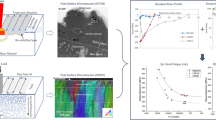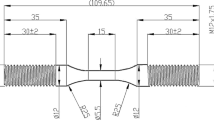Abstract
Electropulsing-assisted ultrasonic surface strengthening (EUSS) is conducted in investigating the fatigue properties of HIP Ti–6Al–4V alloy. The results show that the minimum grain size reaches to nanometer scale and is accompanied by many dislocations. This should be attributed to the effective combination of the athermal effect of pulsed current and ultrasonic shock. Meanwhile, the microhardness value is increased to 530 HV and the hardening depth reaches to 300 μm. The compressive residual stress value drops to − 950 MPa in the thick plastic deformation layer and has an influence depth of 520 μm. Meanwhile, the smooth surface quality of the sample reduces the stress concentrations. The high compressive residual stress value decreases the effectiveness of the formation and propagation of crack initiation sites. Finally, the tensile strength of the sample treated by EUSS is increased to 1104 MPa, and the fatigue life is increased to 2.5 × 105 at 700 MPa and the critical fatigue strength at 107 cycles is increased to 600 MPa. Moreover, the thermal effect of the pulsed current effectively reduces the microscopic defects (crack source) in material surface-modified layer. Therefore, the fatigue crack initiation site originates from the interior of the sample, and rather than on the surface.












Similar content being viewed by others
References
M. Jackson: ACS, Atlanta, 2014, pp. 1–15.
A.K. Sachdev, K. Kulkarni, Z.Z. Fang, R. Yang, and V. Girshov: JOM., 2012, vol. 64(5), pp. 553–65. https://doi.org/10.1007/s11837-012-0310-8.
M. Wen, C. Wen, P. Hodgson, and Y.C. Li: Colloid Surf. B, 2014, vol. 116, pp. 658–65. https://doi.org/10.1016/j.colsurfb.2013.10.039.
N. Khanna and J.P. Davim: Measurement, 2015, vol. 61, pp. 280–90. https://doi.org/10.1016/j.measurement.2014.10.059.
I. Gurrappa: Mater. Charact., 2003, vol. 2–3, pp. 131–39. https://doi.org/10.1016/j.matchar.2003.10.006.
K. Zhang, J. Mei, N. Wain, and X. Wu: Metall. Mater. Trans. A, 2010, vol. 41A, pp. 1033–45. https://doi.org/10.1007/s11661-009-0149-y.
L. Zhu, X.T. Hu, R. Jiang, Y.D. Song, and S.D. Qu: Mater. Sci. Eng. A, 2019, vol. 739, pp. 214–24. https://doi.org/10.1016/j.msea.2018.10.031.
L. Li, M. Kim, S. Lee, M. Bae, and D. Lee: Surf. Coat. Technol., 2016, vol. 307, pp. 517–24. https://doi.org/10.1016/j.surfcoat.2016.09.023.
C.S. Liu, D.X. Liu, X.H. Zhang, D. Liu, A.M. Ma, N. Ao, and X.C. Xu: J. Mater. Sci. Technol., 2019, vol. 35, pp. 1555–62. https://doi.org/10.1016/j.jmst.2019.03.036.
R.J. Sun, Z.G. Che, Z.W. Cao, S.K. Zou, J.F. Wu, W. Guo, and Y. Zhu: Surf. Coat. Technol., 2020, vol. 383, p. 125284. https://doi.org/10.1016/j.surfcoat.2019.125284.
C.S. Liu, D.X. Liu, X.H. Zhang, N. Ao, X.C. Xu, D. Liu, and J. Yang: Int. J. Fatigue, 2019, vol. 125, pp. 249–60. https://doi.org/10.1016/j.ijfatigue.2019.03.042.
Z.Q. Liu, Z. Wang, C.F. Gao, R.P. Liu, Z.Y. Xiao, and J. Sanderson: Mater. Sci. Eng. A, 2022, vol. 833, p. 142352. https://doi.org/10.1016/j.msea.2021.142352.
O. Unal, E. Maleki, I. Karademir, F. Husem, Y. Efe, and T. Das: Int. J. Fatigue, 2022, vol. 155, p. 106613. https://doi.org/10.1016/j.ijfatigue.2021.106613.
H.B. Wang, G.L. Song, and G.Y. Tang: J. Alloy Compd., 2016, vol. 681, pp. 146–56. https://doi.org/10.1016/j.jallcom.2016.04.067.
X.K. Luo, N. Dang, and X. Wang: Int. J. Fatigue, 2021, vol. 153, p. 106465. https://doi.org/10.1016/j.ijfatigue.2021.106465.
H. Zhang, Z.C. Ren, J. Liu, J.Y. Zhao, Z.K. Liu, D. Lin, and R. Zhang: J. Alloy Compd., 2019, vol. 802, pp. 573–82. https://doi.org/10.1016/j.jallcom.2019.06.156.
S.G. Qu, Z.J. Ren, X.F. Hu, F.Q. Lai, F.J. Sun, X.Q. Li, and C. Yang: Surf. Coat. Technol., 2021, vol. 421, p. 127408. https://doi.org/10.1016/j.surfcoat.2021.127408.
S.K. Vajpai, B. Sharma, M. Ota, and K. Ameyama: Mater. Sci. Eng. A, 2018, vol. 736, pp. 323–28. https://doi.org/10.1016/j.msea.2018.09.002.
C.H.V. Satyanarayanaraju, R. Dixit, P. Miryalkar, S. Karunanidhi, A. AshokKumar, J. NagaLakshmi, U. Ramakrishna, R. Mounika, and P. Saipavan: Mater. Today. Proc., 2019, vol. 18, pp. 2409–14. https://doi.org/10.1016/j.matpr.2019.07.088.
C.L. Qiu, X.H. Wu, J.F. Mei, P. Andrews, and W. Voice: J. Alloy Compd., 2013, vol. 578, pp. 454–64. https://doi.org/10.1016/j.jallcom.2013.06.045.
X.L. Xu, Q.Y. Li, J. Wang, X.P. Ren, and H.L. Hou: Mater. Charact., 2021, vol. 180, p. 111399. https://doi.org/10.1016/j.matchar.2021.111399.
G.W. Zhao, J.F. Fan, H. Zhang, Q. Zhang, J. Yang, H.B. Dong, and B.S. Xu: Mater. Sci. Eng. A, 2018, vol. 731, pp. 54–60. https://doi.org/10.1016/j.msea.2018.05.112.
Y.D. Ye, S.Z. Kure-Chu, Z.Y. Sun, X.P. Li, H.B. Wang, and G.Y. Tang: Mater. Des., 2018, vol. 149, pp. 214–27. https://doi.org/10.1016/j.matdes.2018.04.027.
L. Emanuelli, A. Molinari, L. Facchini, E. Sbettega, S. Carmignato, M. Bandini, and M. Benedetti: Int. J. Fatigue, 2022, vol. 162, p. 107009. https://doi.org/10.1016/j.ijfatigue.2022.107009.
S. Huang, J.X. Zhao, J. Sheng, X.K. Meng, E. Boateng, D.H. Ma, J. Li, and J.Z. Zhou: Int. J. Fatigue, 2020, vol. 131, p. 105335. https://doi.org/10.1016/j.ijfatigue.2019.105335.
H. Ye, X. Sun, Y. Liu, X.X. Rao, and Q. Gu: Surf. Coat. Technol., 2019, vol. 372, pp. 288–98. https://doi.org/10.1016/j.surfcoat.2019.05.035.
Y. Wang and Z.L. Su: Theoret. Appl. Fract. Mech., 2021, vol. 111, p. 102849. https://doi.org/10.1016/j.tafmec.2020.102849.
K.S. Chan, M.P. Enright, J.P. Moody, P.J. Golden, R. Chandra, and A.C. Pentz: Int. J. Fatigue, 2010, vol. 32, pp. 815–23. https://doi.org/10.1016/j.ijfatigue.2009.07.004.
A.I. Dekhtyar, B.N. Mordyuk, D.G. Savvakin, V.I. Bondarchuk, I.V. Moiseeva, and N.I. Khripta: Mater. Sci. Eng. A, 2015, vol. 641, pp. 348–59. https://doi.org/10.1016/j.msea.2015.06.072.
W.D. Zhao, D.X. Liu, X.H. Zhang, Y. Zhou, R.X. Zhang, H. Zhang, and C. Ye: Int. J. Fatigue, 2019, vol. 121, pp. 30–38. https://doi.org/10.1016/j.ijfatigue.2018.11.017.
G. Li, F. Meng, and W. Zhang: JOM, 2023, vol. 75, pp. 1739–49. https://doi.org/10.1007/s11837-023-05776-9.
G. Li, X. Xiao, W. Zhang, and D. Song: J. Mater. Process. Technol., 2023, vol. 316, p. 117942. https://doi.org/10.1016/j.jmatprotec.2023.117942.
Acknowledgments
This study were funded by Doctoral Research Fund of Northeast Electric Power University (BSJXM-2019217) and Science and Technology Research Project of Jilin Provincial Department of Education (JJKH20210086KJ)
Author information
Authors and Affiliations
Corresponding author
Ethics declarations
Conflict of interest
The authors declare that they have no known competing financial interests or personal relationships that could have appeared to influence the work reported in this paper.
Additional information
Publisher's Note
Springer Nature remains neutral with regard to jurisdictional claims in published maps and institutional affiliations.
Rights and permissions
Springer Nature or its licensor (e.g. a society or other partner) holds exclusive rights to this article under a publishing agreement with the author(s) or other rightsholder(s); author self-archiving of the accepted manuscript version of this article is solely governed by the terms of such publishing agreement and applicable law.
About this article
Cite this article
Li, G., Xiao, X., Zhang, W. et al. Effect of Electropulsing-Assisted Ultrasonic Strengthening on Fatigue Properties of HIP Ti–6Al–4V Alloy. Metall Mater Trans A 54, 3912–3927 (2023). https://doi.org/10.1007/s11661-023-07142-5
Received:
Accepted:
Published:
Issue Date:
DOI: https://doi.org/10.1007/s11661-023-07142-5




